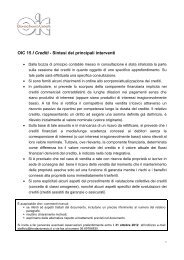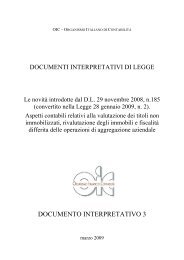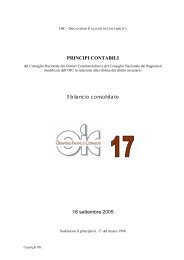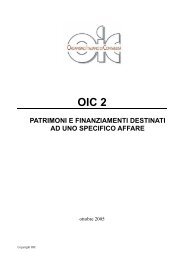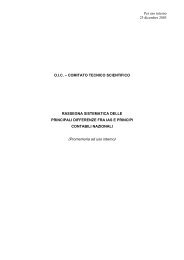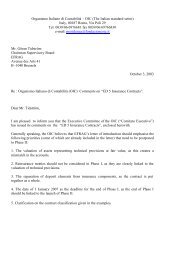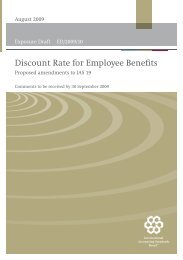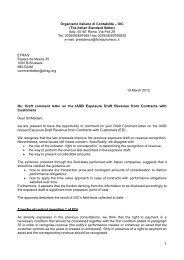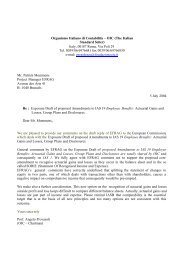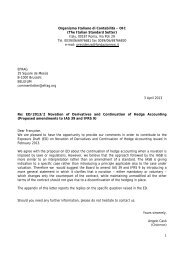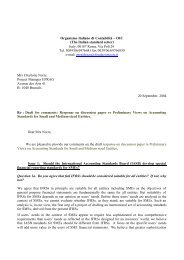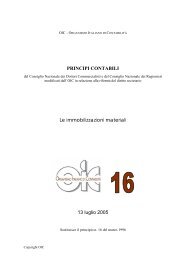OIC comments on EFRAG Draft comment letter on IASB ED of ...
OIC comments on EFRAG Draft comment letter on IASB ED of ...
OIC comments on EFRAG Draft comment letter on IASB ED of ...
- No tags were found...
You also want an ePaper? Increase the reach of your titles
YUMPU automatically turns print PDFs into web optimized ePapers that Google loves.
Organismo Italiano di C<strong>on</strong>tabilità – <str<strong>on</strong>g>OIC</str<strong>on</strong>g>(The Italian Standard Setter)Italy, 00187 Roma, Via Poli 29Tel. 0039/06/6976681 fax 0039/06/69766830e-mail: presidenza@f<strong>on</strong>dazi<strong>on</strong>eoic.it<strong>EFRAG</strong>Avenue des Arts 13-14B -1210 BrusselsBELGIUM<strong>comment</strong><strong>letter</strong>@efrag.org28 November 2008Re: <strong>Draft</strong> <strong>comment</strong> <strong>letter</strong> to Exposure <strong>Draft</strong> <strong>of</strong> Proposed Improvements to IAS33 Simplifying Earnings per ShareDear Sir/MadamWe are pleased to provide our <str<strong>on</strong>g><strong>comment</strong>s</str<strong>on</strong>g> <strong>on</strong> your draft <strong>comment</strong> <strong>letter</strong> to <strong>ED</strong> <strong>of</strong> ProposedImprovements to IAS 33 Simplifying Earnings per Share.General <str<strong>on</strong>g><strong>comment</strong>s</str<strong>on</strong>g>It is our opini<strong>on</strong> that the accounting treatment and related disclosure <strong>of</strong> Earnings perShare should c<strong>on</strong>tinue to be included in the Internati<strong>on</strong>al Accounting Standards. In ourview, it is both appropriate and important that such treatment is disciplined by theStandards, since not all <strong>of</strong> the users <strong>of</strong> the financial statements have available all theinformati<strong>on</strong> necessary to correctly understand the management reas<strong>on</strong>ing behind theresulting earning per share, expressed as a synthetic value. Particularly, the financialanalysts may benefit from a comprehensive treatment <strong>of</strong> such matters within theStandards.Furthermore, it appears that there are other informative elements which are not alwaysbeing cleared to the users: <strong>on</strong>e example is a clear disclosure <strong>of</strong> the net financial positi<strong>on</strong>.A possibility might be to include this matter in the project <strong>on</strong> the ManagementCommentary currently in the <strong>IASB</strong> agenda.The equity/liabilities c<strong>on</strong>vergence project c<strong>on</strong>ducted by the <strong>IASB</strong> and the FASB is likely toresult in a change to the present way <strong>of</strong> distinguishing between equity and liabilitieselements, as well as to underlying c<strong>on</strong>cepts. Therefore, it would seem more logical todefer the project <strong>on</strong> simplifying earnings per share to the time when the equity/liabilities<strong>on</strong>e is completed.1
Questi<strong>on</strong> 1 – Mandatorily c<strong>on</strong>vertible instruments and instruments issuable forlittle or no cash or other c<strong>on</strong>siderati<strong>on</strong>(a) Do you agree that the weighted average number <strong>of</strong> ordinary shares for basic EPSshould include <strong>on</strong>ly instruments that give (or are deemed to give) their holder the right toshare currently in pr<strong>of</strong>it or loss <strong>of</strong> the period? Why or why not?(b) Does the exposure draft apply this principle correctly to mandatorily c<strong>on</strong>vertibleinstruments and ordinary shares issuable for little or no cash or other c<strong>on</strong>siderati<strong>on</strong>? Whyor why not?The <strong>IASB</strong> proposes that the weighted average number <strong>of</strong> ordinary shares for basis EPSshould include <strong>on</strong>ly instruments that give (or are deemed to give) their holder the right toshare currently in pr<strong>of</strong>it or loss <strong>of</strong> the period. Ordinary shares issuable for little or no cashor other c<strong>on</strong>siderati<strong>on</strong> or mandatorily c<strong>on</strong>vertible instruments should be included in thebasic EPS, if they meet this c<strong>on</strong>diti<strong>on</strong>.We support the <strong>IASB</strong>’s proposal to make it clear that the weighted average number <strong>of</strong>ordinary shares for basic EPS should include <strong>on</strong>ly instruments that give (or are deemed togive) their holder the right to share currently in pr<strong>of</strong>it or loss <strong>of</strong> the period. Moreover, webelieve it is correct that this approach be also applied to mandatorily c<strong>on</strong>vertibleinstruments and ordinary shares issuable for little or no cash or other c<strong>on</strong>siderati<strong>on</strong>.We believe that basic EPS should not include instruments that would give rise toc<strong>on</strong>tingent dividends if they are not exercised or c<strong>on</strong>verted. Anyway, we support for anyabove-menti<strong>on</strong>ed instruments that an appropriate disclosure should be provided.Questi<strong>on</strong> 2 – Gross physically settled c<strong>on</strong>tracts to repurchase an entity’s ownshares and mandatorily redeemable ordinary sharesThe Board proposes that the principle for c<strong>on</strong>tracts to repurchase an entity’s own sharesfor cash or other financial assets should also apply to mandatorily redeemable shares? Doyou agree with the proposed treatment <strong>of</strong> gross physical settled c<strong>on</strong>tracts to repurchasean entity’s own shares and mandatorily redeemable shares? Why or why not?The Exposure draft clarifies that ordinary shares subject to a gross physically settledc<strong>on</strong>tract to repurchase entity’s own shares should be excluded from the denominator <strong>of</strong>the EPS calculati<strong>on</strong> since such transacti<strong>on</strong> is equivalent to <strong>on</strong>e in which the entity hadalready repurchased the shares. Such a c<strong>on</strong>tract gives rise to a financial liability for thepresent value <strong>of</strong> the redempti<strong>on</strong> amount, as said in IAS 32. To calculate EPS the dividendsare allocated to the liability and, c<strong>on</strong>sequently, the liability meets the definiti<strong>on</strong> <strong>of</strong> aparticipating instrument. On the c<strong>on</strong>trary, when the c<strong>on</strong>tract requires the holder <strong>of</strong> theinstrument to remit back to the entity any dividends paid <strong>on</strong> the shares to berepurchased, the liability is not a participating instrument.The <strong>IASB</strong> proposes to apply the same treatment (i.e. exclusi<strong>on</strong> from the EPSdenominator) to mandatorily redeemable ordinary shares.We c<strong>on</strong>cur whit the <strong>IASB</strong>’s proposal to exclude these instruments from the denominator<strong>of</strong> the EPS calculati<strong>on</strong>, because the cash flows from those shares are not an outflow fromthe entity. In other words, their effect would be an increase in the carrying value <strong>of</strong> theportfolio <strong>of</strong> such instruments with a corresp<strong>on</strong>ding decrease in net equity (undistributedearnings).2
Questi<strong>on</strong> 3 – Instruments that are measured at fair value through pr<strong>of</strong>it or lossDo you agree that the fair value changes sufficiently reflect the effect <strong>on</strong> ordinary equityholders <strong>of</strong> instruments measured at fair value through pr<strong>of</strong>it or loss and that recognizingthose changes in pr<strong>of</strong>it or loss eliminates the need for further adjustments to thecalculati<strong>on</strong> <strong>of</strong> EPS? Why or why not?According paragraphs 26-27 <strong>of</strong> the exposure draft the denominator shall not increase forthe number <strong>of</strong> additi<strong>on</strong>al ordinary shares that would arise from the exercise or c<strong>on</strong>versi<strong>on</strong><strong>of</strong> instruments (or the derivative comp<strong>on</strong>ents <strong>of</strong> compound instruments) that aremeasured at fair value through pr<strong>of</strong>it or loss. The Board observes that the numeratorreflects the changes in fair value and as a c<strong>on</strong>sequence no adjustment is needed.We observe that should all financial instruments measured at fair value through pr<strong>of</strong>it andloss be excluded from the computati<strong>on</strong> <strong>of</strong> EPS, this would include also those instrumentswhich are likely to have a dilutive effect. For example, the applicati<strong>on</strong> <strong>of</strong> the proposedprinciple would not take into computati<strong>on</strong> the dilutive effect <strong>of</strong> a put opti<strong>on</strong> “in them<strong>on</strong>ey” <strong>on</strong> ordinary shares measured at FVTPLWe note that the measurement at FVTPL can include also instruments negotiatedbetween the entity and equity holders acting in their capacity as equity holders. We dobelieve this kind <strong>of</strong> relati<strong>on</strong>s should not accounted for to pr<strong>of</strong>it or loss but to equity. Wealso do not believe appropriate that they are measured at FVTPL. As a c<strong>on</strong>sequence, wesuggest to amend IAS 39 rec<strong>on</strong>sidering which type <strong>of</strong> instrument should be measured atFVTPL under the Standard.As discussed in the “General <str<strong>on</strong>g><strong>comment</strong>s</str<strong>on</strong>g>” above, the definiti<strong>on</strong> <strong>of</strong> the types <strong>of</strong> instrumentsto be recognised as elements <strong>of</strong> equity or liabilities will likely change from the current <strong>on</strong>eat the completi<strong>on</strong> <strong>of</strong> the equity/liabilities project. Hence, we believe that the amendment<strong>of</strong> IAS 33 should be deferred at the time when the equity/liabilities project is completed.Although we do not fully c<strong>on</strong>cur with the <strong>IASB</strong>’s proposal we nevertheless believe that itwould be appropriate that the number <strong>of</strong> opti<strong>on</strong>s which might be c<strong>on</strong>verted and thenumber <strong>of</strong> shares that would result from their c<strong>on</strong>versi<strong>on</strong> be disclosed, in line with the<strong>EFRAG</strong>’s proposal in its paragraph 11.Questi<strong>on</strong> 4 – Opti<strong>on</strong>s, warrants and their equivalents(a) Do you agree that to calculate diluted EPS an entity should assume the settlement <strong>of</strong>forward sale c<strong>on</strong>tracts <strong>on</strong> its own shares in the same way as opti<strong>on</strong>s, warrants and theirequivalents? Why or why not?For diluted EPS an entity assumes the exercise <strong>of</strong> dilutive opti<strong>on</strong>s, warrants and theirequivalents, not measured at FVTPL. The exposure draft proposes to clarify that fordiluted EPS calculati<strong>on</strong> an entity assumes the settlement <strong>of</strong> forward c<strong>on</strong>tracts to sell itsown shares, unless the c<strong>on</strong>tract is measured at fair value through pr<strong>of</strong>it or loss.We agree to assume the settlement <strong>of</strong> forward c<strong>on</strong>tracts to sell entity’s own sharesbecause these c<strong>on</strong>tracts have a dilutive effect.(b) Do you agree that ordinary shares arising from the assumed exercise or settlement <strong>of</strong>opti<strong>on</strong>s, warrants and their equivalents should be regarded as issued at the end-<strong>of</strong>-periodmarket price? Why or why not?3
To simplify the calculati<strong>on</strong> <strong>of</strong> diluted EPS the exposure draft proposes that the ordinaryshares arising from the assumed exercise or settlement <strong>of</strong> those potential ordinary sharesshould be regarded as issued at the end-<strong>of</strong>-period market price, rather than at theiraverage market price during the period.We agree <strong>on</strong> adopting <strong>of</strong> the end-<strong>of</strong>-period market price, rather than the average <strong>on</strong>eduring the period, since it simplifies the calculati<strong>on</strong> <strong>of</strong> diluted EPS and provides morerelevant informati<strong>on</strong>.Questi<strong>on</strong> 5 – Participating instruments and two-class ordinary sharesDo you agree with the proposed amendments to the applicati<strong>on</strong> guidance for participatinginstruments and two-class ordinary shares? Why or why not?The Exposure draft proposes to extend the scope <strong>of</strong> the applicati<strong>on</strong> guidance forparticipating instrument to include those classified as liabilities and to amend theapplicati<strong>on</strong> guidance for participating instruments and two-class ordinary shares. Theproposed applicati<strong>on</strong> guidance would introduce a test to determine whether a c<strong>on</strong>vertiblefinancial instrument would have a more dilutive effect if the applicati<strong>on</strong> guidance inparagraph A26 and A27 for participating instruments and two-class ordinary shares isapplied or if c<strong>on</strong>versi<strong>on</strong> is assumed. To calculate diluted EPS the entity would assume themore dilutive alternative. In additi<strong>on</strong> the proposed guidance would require that, if the testcauses an entity to assume c<strong>on</strong>versi<strong>on</strong> <strong>of</strong> the dilutive c<strong>on</strong>vertible instruments, diluted EPSwould not include dividends that might have been payable had c<strong>on</strong>versi<strong>on</strong> occurred at thebeginning <strong>of</strong> the period.We agree with the <strong>IASB</strong>’s proposal and we welcome a detailed guidance. The proposedmethodology is in line with the approach <strong>of</strong> choosing the more restrictive soluti<strong>on</strong>.Questi<strong>on</strong> 6 – Disclosure RequirementsThe Board does not propose additi<strong>on</strong>al disclosures bey<strong>on</strong>d those disclosures alreadyrequired in IAS 33. Are additi<strong>on</strong>al disclosures needed? If so, what additi<strong>on</strong>al disclosuresshould be provided and why?We think that the amount a type <strong>of</strong> disclosures already required is sufficient and it is notnecessary any additi<strong>on</strong>al informati<strong>on</strong> other than the <strong>on</strong>e suggested under questi<strong>on</strong> 3.Yours sincerely,Angelo Casò(<str<strong>on</strong>g>OIC</str<strong>on</strong>g> Chairman)4



